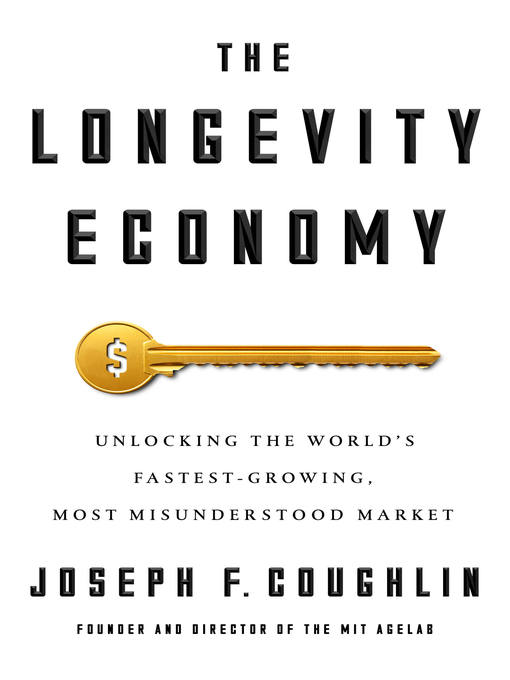Most Americans aren’t optimistic about getting older and think the source of the problem is aging itself. So do most policy wonks: they frame population aging as a set of choices about how to care for an avalanche of “frail and needy elderly.” MIT’s Joseph F. Coughlin and I don’t share that myopia. His latest book, The Longevity Economy (2017), is packed with big ideas about the “dramatic-yet-predictable” effects of the new longevity, which he and I think presents a remarkable opportunity to build a better old age.
We also know that what stands between olders and this brighter future is the culture itself. But he’s putting his faith in corporations to “do the right thing” while I envision a very different engine of change.
Coughlin founded the MIT AgeLab, which “applies consumer-centered systems … to catalyze innovation across business markets,” so it’s not surprising that his approach to the longevity boom is market driven.
“It’s as though a whole new continent were rising out of the sea, filled with more than a billion air-breathing consumers just begging for products that fulfill their demands,” he writes. Soon, he predicts, “the world’s most advanced economies will evolve around the needs, wants, and whims of grandparents.”
The products and technologies that emerge to meet those needs won’t just be highly profitable. By improving the quality of life of older Americans in countless yet-to-be-imagined ways, the book predicts, they will enlarge and enrich the way we experience old age itself. It’s a bold proposition, and it’s also misguided.
What stands between us and this better old age? Why are companies failing to “wake up, smell the Ensure”—which, Coughlin points out, is pretty much Soylent marketed to olders? Why don’t corporations start courting older consumers with all the fervor they currently lavish on millennials? Because of “our very idea of old age [emphasis mine], which is socially constructed, historically contingent and deeply flawed,” he writes.
“Socially constructed,” as I often say, is sociology-speak for “we make it up,” and we’re in synch when Coughlin declares “Old age is made up” [emphasis his].
Not made up like a fun game, made up like a shared delusion. Call it a “collective case of blindness” as Coughlin does. Call it implicit bias, as he also describes it. That would be prejudice against older people so deeply ingrained that you might not even know you harbor it. Call it “ageism,” as I do, and why Coughlin fails to is beyond me; the word barely appears in The Longevity Economy.
But although our approaches differ, we agree on the heart of the problem: an ageist culture that confines olders to the margins of society and sanctions only the blandest of “age appropriate” behaviors: relaxing, volunteering, grandparenting and falling apart.
Who’s going to drive the necessary social change? Not olders themselves, Coughlin writes, “because their ability to picture new, better ways to live is utterly constrained by our current, pernicious narrative.” The drivers, he says, will be the corporate visionaries who understand that olders aspire to the same stuff as everyone else does—work, romance, purpose, imagine that!—and who create the products that enable those aspirations.
“By building a vision of late life that is more than just a miserable version of middle age, companies won’t just be minting money . . . they’ll also be creating a cultural environment that values the contributions of older adults.” The result will be a virtuous circle: by enriching and enlarging our vision of late life, better products will bring it about.
I love Coughlin’s vision of “a new narrative of possibility in old age,” but I don’t think it’s going to emerge from the business community. Corporations can speed social change, and they can definitely commodify it, turning sisterhood into grrl power into the Spice Girls, for example. But they exist to profit, not provoke, and it’s easy to monetize fear and insecurity. Who says wrinkles are ugly? The multibillion-dollar, anti-aging, skin-care industry. Who says perimenopause and “low T” and mild cognitive impairment are medical conditions? The trillion-dollar pharmaceutical industry. Why would corporations be instrumental in overturning prejudices from which they profit on this scale?
So I stumble over Coughlin’s belief that “More than any other factor, this new story [of old age] will be built on the testimony of longevity-economy products.” Really? A seismic cultural shift driven by consumer behavior? The longevity economy will bequeath us lists of service providers and garages full of tools and toys. But olders want to downsize, and products will have to be both indispensable and affordable in order to reach a mass market.
More importantly, products alone cannot transform the world in which we use them. For-profit ventures aren’t in the better-life-for-everyone business because the masses lack the disposable income to power wholesale culture change. If the goal is to go beyond meeting older people’s basic needs—to support growth and voice and visibility for all, lifelong—how do we develop the rituals, roles, and institutions that will be essential to achieving that goal? Why would we trust the private sector to start operating in the interests of the entire cohort, not just those in the 9.9 percent, the new American aristocracy (for more about that, see this piece in the Atlantic).
I have different ideas about what it will take to make aging a better experience. I’ll explain them in part 2 of this blog.



